More Than Checking Boxes: Why Data Collection Systems Must Prioritize Equity

Throughout my life, I’ve struggled to fill out forms that require me to specify my race. Not because I feel uncomfortable with my race, but because the race I identify as is simply not included as one of the category checkboxes.
There are five race categories that fall under the White House Office of Management and Budget’s (OMB) standards for race and ethnicity—American Indian or Alaska Native, Asian, Black or African American, Native Hawaiian or Other Pacific Islander, and White. I often think about how this classification makes people in some communities who don’t self-identify as belonging to one of these race categories feel invisible.
As an Egyptian American, I identify as being Middle Eastern and North African, however, standards set by OMB classify people with roots in the Middle East or North Africa as “White.” Responses to race questions are based on self-identification. Since I personally don’t identify as being White, I am left with two choices—either tick the “White” checkbox simply for the sake of following OMB’s standards or tick the “Other” checkbox, truly making me feel like “the other.'' Both options are similar in that they fail to make me feel seen and represented.
When I was younger, filling out race classification questions would confuse me. When I got older, the lack of representation made me feel frustrated. And now, after seeing the effects that this classification is having on Middle Eastern and North African (MENA) communities in the United States during the COVID-19 pandemic, I feel deeply concerned. How health data is collected and analyzed during this global health crisis shapes how we as a society respond. The pandemic has highlighted that this issue goes beyond my concern of feeling underrepresented. It’s a larger public health issue, and it’s made me realize just how much one checkbox matters.
As many individuals of MENA descent, like me, continue to be required to tick the “White” or “Other” checkboxes on forms, including on medical forms, the lack of racial or ethnic identifiers has limited the ability to collect accurate health data and has made it difficult to measure the impact of the pandemic on MENA communities. Can we truly determine how many people who self-identify as Middle Eastern or North African have been affected by COVID-19 without accurate data?
The pandemic has disproportionately affected people of color across the country. What our communities need is to be heard and represented, to have our needs addressed and funded, and to be afforded the proper resources to thrive.
I am grateful to be supporting the work of the Robert Wood Johnson Foundation’s first-of-its-kind National Commission to Transform Public Health Data Systems. The commission takes a deep dive to identify ways in which we can modernize our public health data infrastructure with an eye toward equity. Questions that are often overlooked but are needed to improve our data collection systems are examined by the commission: Who does the data we collect elevate? Who is centered in the data? Who is excluded and why? It’s crucial that we continue to ask these questions to keep underrepresented communities healthy and safe.
Prior to joining Burness, I supported Arab American outreach efforts for the Biden for President campaign. As part of President Biden’s plan for a partnership with the Arab American community, he stated his support for the creation of a new MENA category for those who identify as such to be fairly counted and considered. While this has yet to happen, I remain hopeful to see change.
It’s clear that we must persist to help underrepresented communities feel heard, seen and properly accounted for when it comes to health data collection. It ultimately involves much more than checking a box to get us closer to achieving health equity and closing gaps in health disparities. But, if you ask me, that’d be a good start.